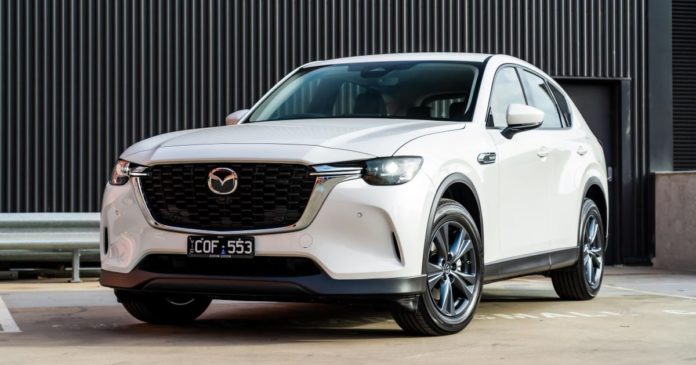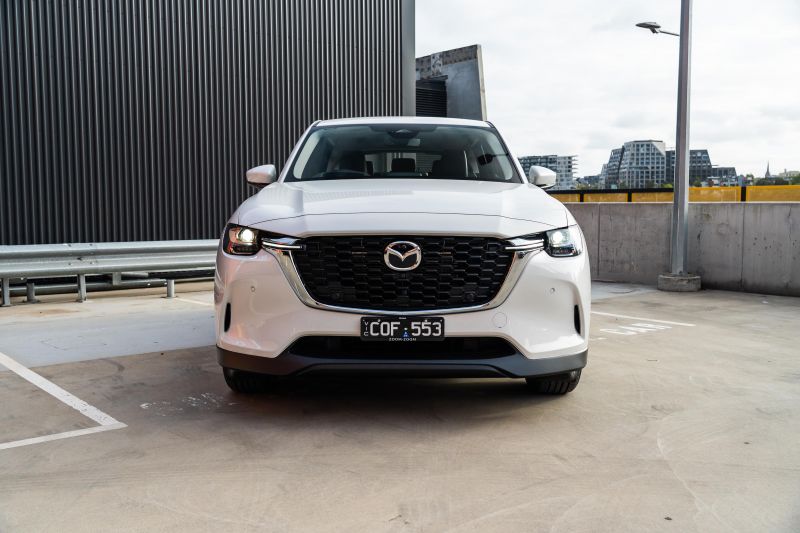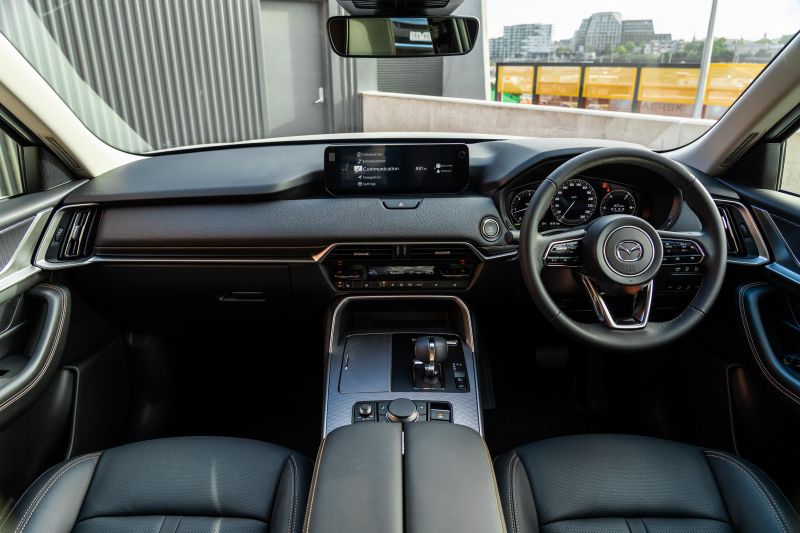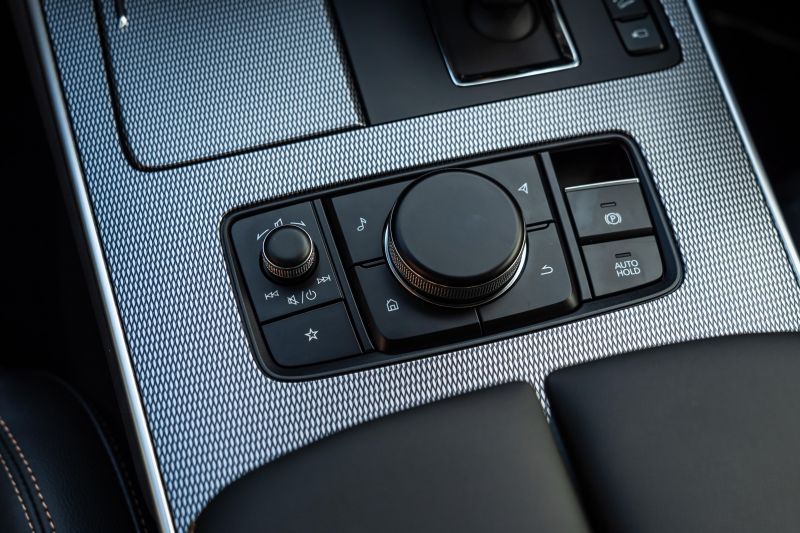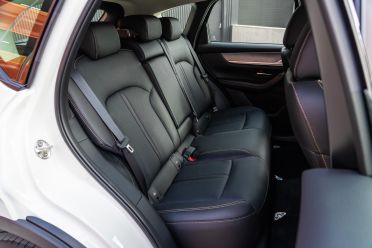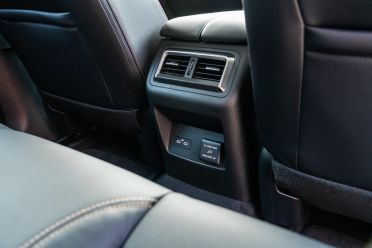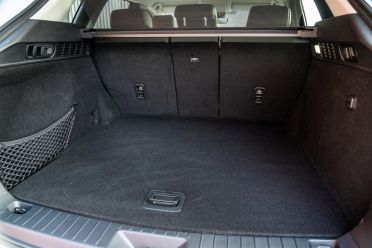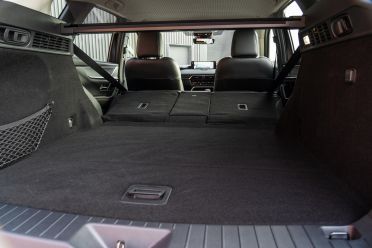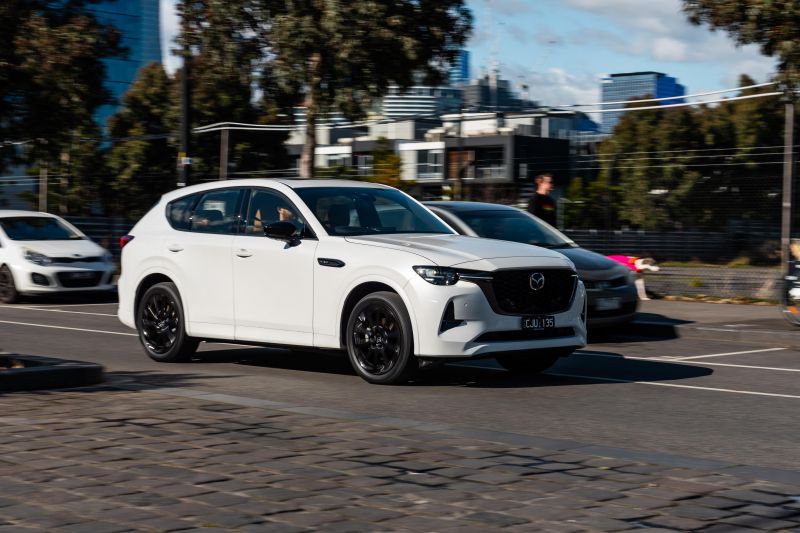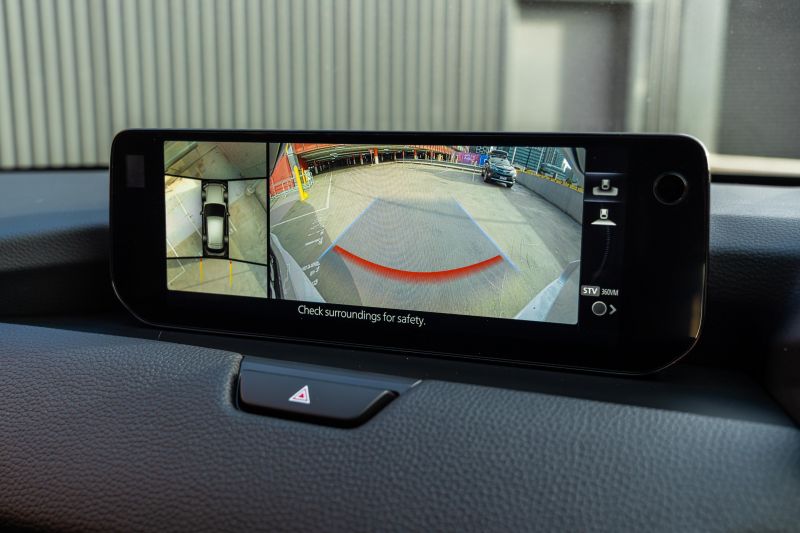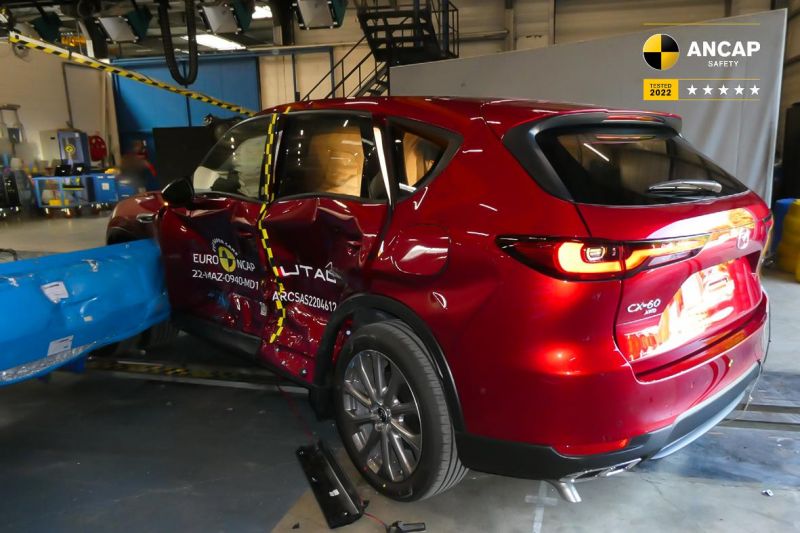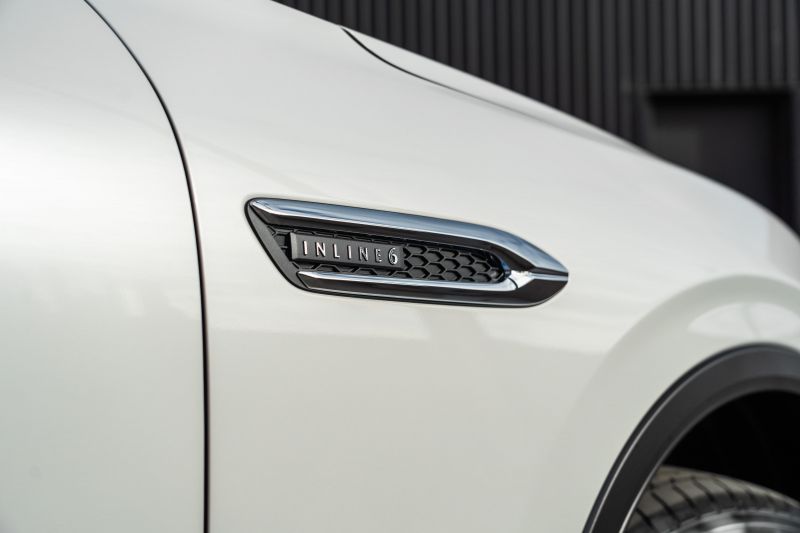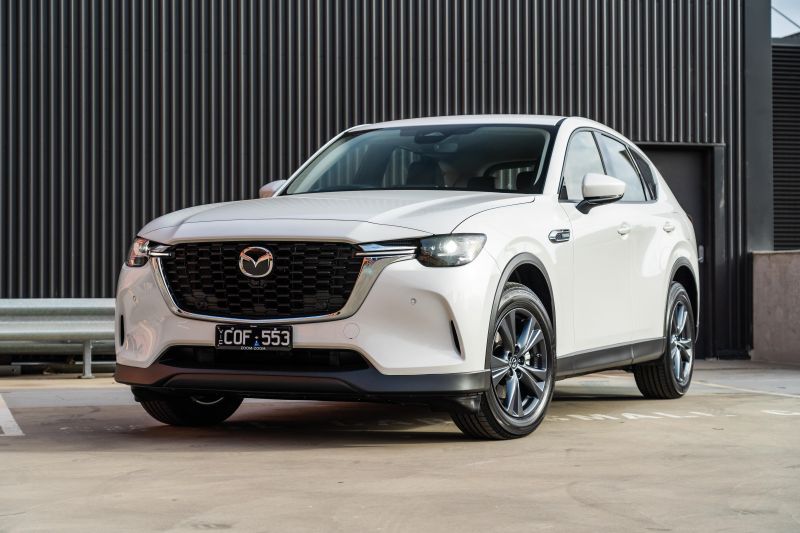Australians love a top-of-the-range model, but there’s often a lot of goodness further down the range.
Take the Mazda CX-60, which has had a lot of hype around the flagship grades – but little attention given to the base Evolve, which is relatively attainable at a little over $60,000 plus on-road costs.
Mazda’s new mid-sized SUV extends beyond the price bracket any CX-5 has played in, but still has a strong focus on value compared to German alternatives. It also offers a stepping stone beyond the brand’s existing core models once a CX-5 or CX-8 become too vanilla.
Since its launch, Mazda has introduced some running changes for the rear suspension and transmission software following feedback from the media and customers, and the 2024 Mazda CX-60 D50e Evolve on test is our first taste of the revisions, as well as a first drive of the base grade.
Following the aforementioned running changes as well as recent price adjustments, does the base CX-60 make more sense compared to its more premium siblings?
And, is it worth the jump over something like a top-spec CX-5? Well, read on to find out.
How does the Mazda CX-60 compare?
View a detailed breakdown of the Mazda CX-60 against similarly sized vehicles.

Mazda
CX-60
How much does the Mazda CX-60 cost?
The 2024 Mazda CX-60 D50e Evolve is the second most affordable variant in the range, priced from $62,550 plus on-road costs. It commands a $2000 premium over the petrol-powered G40e Evolve in the same specification.
2024 Mazda CX-60 pricing:
Evolve
- G40e M Hybrid: $60,550
- D50e M Hybrid: $62,550
- P50e PHEV: $73,600
GT
- G40e M Hybrid: $68,550
- D50e M Hybrid: $70,550
- P50e PHEV: $81,600
Azami
- G40e M Hybrid: $73,750
- D50e M Hybrid: $75,750
- P50e PHEV: $86,800
Prices exclude on-road costs
To see how the Mazda CX-60 lines up against its rivals, check out our comparisons tool.
What is the Mazda CX-60 like on the inside?
The Evolve with Luxury Pack isn’t all that different to the mid-spec GT in terms of presentation.
It’s less flashy than the available white and tan interiors of the Azami’s Takumi and SP packages, but there’s a general sense of upmarket-ness to the base CX-60’s cabin that also comes with some Mazda familiarity.
Everything is designed to look solid and robust, with a lot of straight lines and flat surfaces. It has a real impression of size and width, and Mazda has done a good job with the mix of materials and textures even if everything is 50 shades of black and grey.
It’s a shame the Evolve isn’t offered with the Revera Stone leather option available on the GT, but for those concerned about jeans and messy kids marking a lighter hide, the black interior may do just fine for most.
As is the Mazda way, there’s a hint of Lexus to how everything is laid out and presented, with more buttons and switches than most as well as clean, consistent typeface and clear digital displays.
The Evolve comes as standard with 7.0-inch TFT digital instrument display flanked by analogue gauges like you see on most other Mazda models, but with the $4000 Luxury Pack as tested it upgrades to a nicer 12.3-inch fully digital unit.
While fairly minimal on the customisation front, the Mazda’s virtual instrument panel apes classic gauges well and offers fluid animations. I’m not a fan of how turning on the cruise control locks you into a driver assist layout that minimises the pretty virtual dials.
Evolve-spec models also get a smaller 10.25-inch Mazda Connect infotainment system than the 12.3-inch units offered in GT and Azami models, which also appears to forego the available touch input function for smartphone mirroring.
It’s otherwise decently kitted out, with standard satellite navigation, DAB+ radio, as well as wireless Apple CarPlay and Android Auto. My iPhone 15 Pro Max worked flawlessly via wireless connection for the duration of our loan.
Mazda will be launching connected services across its lineup gradually in the coming year or so, meaning we should hopefully see extended net-based functionality added as a running update.
The standard eight-speaker sound system worked well, with clear sound and decent bass, though the 12-speaker Bose premium audio setup offered by the GT and Azami is a good step up.
Seat comfort up front is good, with nicely padded and supportive seats that are trimmed as standard in Maztex fake leather, though our Luxury Package-equipped tester features leather-accented upholstery. The Luxury Pack also brings powered front seat adjustment with memory presets for the driver – I’d be ticking this $4000 box, personally.
Storage around the front of the cabin is decent, if not standout. You get decent door bins and a cubby under the centre armrest – which folds out two ways mind you – and there’s a rubberised mat for your phone on the wireless phone charger under the centre stack.
You also get two cupholders under a dampened lid and USB-C charging ports in the front console area.
The second row isn’t massive, but it’s larger than a CX-5 and competitive with the Audi Q5 or Mercedes-Benz GLC – if not quite BMW X3 good.
I’m 6’1 and had enough head-, knee- and toe room to get comfortable, with a good view out the rear windows. I’d wager two adults will be fine, three would be a pinch. The minimal centre tunnel at least means a centre passenger isn’t too impeded in terms of foot space.
Amenities include rear air vents – though no separate climate controls – as well as USB-C and 150W AC outlets to keep devices charged. The GT and Azami score heated outboard seats, but not here.
There’s a fold-down centre armrest with cupholders, map pockets behind the front seats, as well as ISOFIX anchors on the outer positions and top-tethers across all three rear seats. Bottle holders in the doors round out the notable practicality features.
Cargo volume is quoted at 477 litres “to rear package tray” with all seats up, expanding to 1726 litres “to ceiling with underfloor storage space” with the rear seats folded.
That’s just under 40 litres better than the CX-5 with five seats in use, and nearly 400 litres better with the rear seats folded. Not bad, but somewhat off the pace of premium rivals like the Audi Q5 (520L-1520L), BMW X3 (550L-1600L) and Mercedes-Benz GLC (620L) with all seats in use.
Remote levers to drop the rear seats feature in the cargo area, and the PHEV adds a 1500W AC outlet there too. Mild-hybrid versions get a space-saver spare wheel whereas PHEVs get a tyre repair kit.
What’s under the bonnet?
On test we have the CX-60 D50e, which is powered by a mild-hybrid six-cylinder turbo-diesel engine.
| Model | Mazda CX-60 D50e |
|---|---|
| Engine | 3.3L 6cyl turbo-diesel 48V mild-hybrid |
| Power | 187kW (3750rpm) |
| Torque | 500Nm (1500-2400rpm) |
| Electric motor | 12.4kW 153Nm |
| Battery | 0.33kWh li-ion |
| Transmission | 8-speed automatic |
| Driven wheels | All-wheel drive |
| Weight | 1963kg (kerb) |
| 0-100km/h | 7.3 seconds |
| Fuel economy (claim) | 4.9L/100km |
| Fuel economy (as tested) | 5.5L/100km |
| Fuel tank size | 58L |
| Fuel requirement | Diesel |
Our indicated fuel figure was achieved over 860 kilometres of mixed driving, including a return trip from Melbourne to Yarrawonga on the VIC-NSW border.
How does the Mazda CX-60 drive?
Having spent plenty of time in the diesel CX-60, I was interested to see if there were any notable changes with the smaller wheels; and of course the updated rear suspension hardware and powertrain control unit software.
-
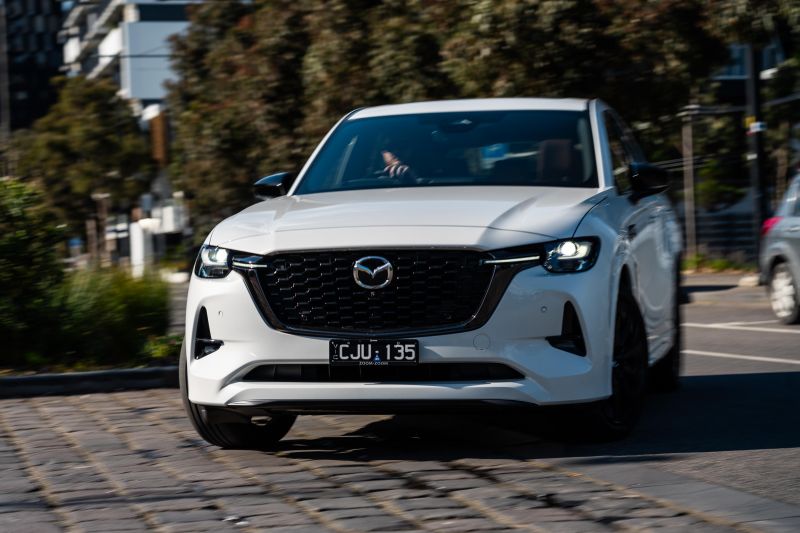
Azami SP Package shown
The bulk of my time with the CX-60 was spent doing my usual commuting to and from the office, mixed in with a return trip to the Victorian border.
Without having tested this back-to-back with another CX-60 pre upgrades, I felt a difference in the smoothness and response of the transmission, which does without a conventional torque converter and instead features a multi-plate clutch and integrated electric motor-generator.
Mazda claims this helps to improve fuel efficiency and throttle response over a conventional automatic, thanks to the fact torque outputs of the engine and electric motor are directly transmitted to the gearbox “with fast and rhythmic shifting” akin to a manual transmission.
While the launch calibration offered pretty quick shifts under load, it had the tendency to slur and groan through shifts in low-speed scenarios, at times feeling elastic or unresponsive at awkward city speeds between first and second.
This particular CX-60 was a tad smoother and more refined in these conditions than I recall of launch examples, though at times you could still hear the mechanical sounds from the driveline that may be unsettling for some.
As for the overall dynamic character as well as the ride and handling, the steering is still heavy and the ride still quite firm… but it the revised rear shock absorbers, and smaller wheels and tyres on this base model, take some of the edge off.
The CX-60 still communicates just about every road surface imperfection you drive on, and can still be a bit unsettled over shorter, sharper hits. It deals with undulations pretty well, and turns in quite keenly especially at higher speeds.
It’s nicely settled on the highway. That said, there were one or two instances on the Hume where a sharp join sent a thud through the cabin. I’d be interested to see if models on 20-inch wheels would be similar, better or worse in this scenario.
While the CX-60’s very weighty steering makes it feel sporty and substantial on the freeway or up a winding B-road, it can make lower speed manoeuvres in tight suburban streets and carparks a bit more of a chore.
It requires quite a bit of arm work for these everyday tasks, and while some will arm to it others may find it a bit too demanding.
The surround camera system as part of the Luxury Pack makes visibility that much better for tight parks or squishy gaps in traffic even if it’s not of the highest definition – it’s a shame you need to pay minimum $2000 for the privilege.
Insulation from road and wind noise, meanwhile, is adequate but not standout. There was a bit of tyre roar on the Hume Highway, and more than something like an Audi Q5 or BMW X3.
As for assistance systems the Luxury Pack-equipped CX-60 Evolve is pretty much decked out with everything available in the flagship Azami.
Mazda’s Cruising and Traffic Support is one of the more intuitive and natural feeling autonomous highway assistants of its type, and the addition of a surround camera makes visibility while parking that little bit better.
Front and rear cross-traffic alert are handy when pulling out of tight carparks or T-intersections, though the bong from the warning can grate. Blind-spot monitoring is standard, though as is typical of a lot of Mazdas, the magnified driver’s mirror can take some getting used to.
The driver attention monitoring function, unlike some other new vehicles on the market today, also seemed to be less aggressive and didn’t feel the need to chime and visually alert whenever you glance away from the road.
What do you get?
The Evolve is the entry-level trim in the Australian CX-60 lineup.
CX-60 Evolve highlights:
- 18-inch alloy wheels, Grey
- Auto LED headlights
- Auto high-beam
- Rain-sensing wipers
- Body colour exterior mirrors
- Side mirrors with:
- Power adjustment
- Auto folding
- Heating
- Auto-dimming
- Honeycomb grille design
- Black wheel arches and lower cladding
- Remote operated power tailgate (open/close)
- G-Vectoring Control Plus
- 10.25-inch Mazda Connect infotainment system
- 7.0-inch TFT LCD instrument cluster (G40e, D50e)
- 12.3-inch TFT LCD instrument cluster (P50e)
- Head-up display
- DAB+ digital radio
- Satellite navigation
- 8-speaker sound system
- Wireless Apple CarPlay, Android Auto
- Wireless phone charger
- Front USB-C charging points
- Rear console incl. USB-C, 150W AC outlets
- Rear 1500W AC power outlet socket (PHEV)
- Keyless entry, push-button start
- Dual-zone climate control
- Auto-dimming rear-view mirror
- Electric park brake with auto-hold
- One-touch power windows
- Leather steering wheel
- Leather shift knob
- Black Maztex upholstery
- Manual front seat adjustment
Options
The Evolve is available with two optional packages – our tester was fitted with the Luxury Package.
Vision Technology Package: $2000 (Evolve, GT)
- Surround-view camera with see-through view
- 12.3-inch digital instrument cluster (G40e, D50e Evolve)
- Adaptive LED headlights (GT)
- Cruising & Traffic Support
- Driver monitoring
- Front cross-traffic alert
Luxury Package: $4000 (Evolve)
- Vision Technology
- Exterior mirror memory
- Leather upholstery, Black
- Heated front seats
- Power front seat adjustment
Is the Mazda CX-60 safe?
The CX-60 wears a five-star ANCAP safety rating based on Euro NCAP testing in 2022.
The Mazda CX-60 was tested against 2020-2022 criteria by sister organisation Euro NCAP.
It scored 91 per cent for adult occupant protection, 93 per cent for child occupant protection, 89 per cent for vulnerable road user protection and 77 per cent for safety assist.
Standard safety features include:
- 10 airbags incl. front-centre airbag
- Adaptive cruise control
- Autonomous emergency braking (AEB)
- Forward incl. Pedestrian, Cyclist detection
- Reverse
- Junction assist (Turn-across Traffic)
- Blind-spot monitoring
- Driver attention monitoring
- Forward obstruction warning
- High Beam Control (auto high-beam)
- Lane-keep assist
- Parking sensors front, rear
- Rear cross-traffic alert
- Surround camera system
- Traffic sign recognition
- Tyre pressure monitoring
- Vehicle exit warning
CX-60 Azami adds:
- Adaptive LED Headlights
- Cruising & Traffic Support
- Adaptive cruise + lane centring
- Front cross-traffic alert
- 360-degree cameras incl. See Through View
The Azami’s additional safety equipment can be optioned in both the Evolve and GT grades through the Vision Technology Package.
How much does the Mazda CX-60 cost to run?
Like the wider Mazda range, the CX-60 is covered by a five-year, unlimited-kilometre warranty. The high-voltage battery in PHEV models is also covered by an eight-year factory warranty.
Scheduled servicing is required every 12 months or 15,000 kilometres (whichever comes first) for the G40e M Hybrid and the P50e Plug-in Hybrid; while the D50e M Hybrid quotes shorter 10,000km intervals.
Pricing is on the higher side, and is more expensive than the likes of BMW and Genesis.
Mazda CX-60 service pricing:
| Engine | 1st Service | 2nd Service | 3rd Service | 4th Service | 5th Service |
|---|---|---|---|---|---|
| P40e 3.3L i6 MHEV | $447 | $654 | $568 | $749 | $463 |
| D50e 3.3L i6 MHEV | $478 | $643 | $975 | $643 | $478 |
| P50e 2.5L i4 PHEV | $478 | $643 | $975 | $643 | $478 |
CarExpert’s Take on the Mazda CX-60
It may not look as sexy as the GT and Azami grades, but the CX-60 Evolve could make the most sense.
Where some of its quirks are hard to excuse at the more expensive Azami’s price point, the base model’s unique and efficient drivetrains give it some breathing room in the $60,000 price bracket.
Here you have a six-cylinder SUV that’s larger than most competitors – and to get a similarly powerful drivetrain in an Audi or BMW will cost you twice as much. Add the Luxury Pack, and you have a pretty well featured premium-leaning SUV for a little over $65,000 plus on-roads.
It’s not perfect. Despite running changes to the rear suspension and transmission, the CX-60 is a harsher and less unrefined than you might expect of something claiming to be a luxury car. On the flipside it’s one of the more fun and engaging SUVs to drive.
Add to that the fact it offers efficiency that rivals smaller hybrids, and there’s a lot to like. Don’t be afraid to take one out for a test drive if you’re in market to see if the ride and handling tune suits your tastes.
Click the images for the full gallery
MORE: Buy a Mazda CX-60
MORE: Everything Mazda CX-60

